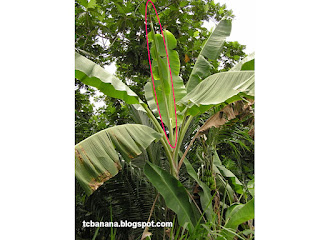Calcium (Ca) deficiency symptoms:
- Young leaves show interveinal chlorosis near the margins and towards the tip.
- When these chlorotic patches die they create a serrated necrosis along the leaf margin.
- A temporary shortage of calcium causes the “spike leaf” symptoms in the field in which the lamina of new leaves is deformed or almost absent with thickened lateral veins near the mid-rib and deficient root system which is susceptible to rot.
- Fruit quality is inferior and the peel splits when the fruit is ripe.
(Boron and Calcium deficiency symptoms tend to overlap. So see Boron deficiency pictures also).
Picture 1: Ca deficiency-Early foliar symptom -
Yellow stripes parallel to leaf midrib.
Yellow stripes parallel to leaf midrib.
Picture 2: Ca deficiency-Early foliar symptom -
Yellow stripes parallel to leaf midrib.
Picture 5: Boron and Calcium deficiency - "SPIKE LEAF" (in which the lamina of new leaves is deformed or almost absent).
(Photos credit: ctahr, Hawaii)
Control Measures:
a. Drip fertigation of Calcium Nitrate (CaNo3) @ 4 kg/1000 plants every 4th day upto 5th month.
(OR)
b. Manual application of Calcium nitrate (CN)) @ 40g/plant per month upto 5th month and if necessary till finger development. Application of CN provides calcium as well as nitrogen (15.5-0-0 + 19% Ca) to the soil, therefore quantity of nitrogen needs to be adjusted with the total nitrogen requirement of the soil.
The picture below shows a plant affected due to Calcium and Boron deficiency and the subsequent recovery after the remedial measures taken as under:
Step 1: Drenching the growing shoot (by applying inside the emerging unfurled funnel shaped leaf) with 100 ml of foliar grade boron rich micronutrient solution.
Step 2: Fertigation of Calcium Nitrate @ 20 gm / plant (in 2 split doses).
Note: If the deficiency is severe, 3 to 4 foliar applications of micronutrients have to be given to the crop up to 7 months along with fertigation of Calcium Nitrate @ 75 gm / plant in 5 to 7 split doses.
Sources of Calcium:
Lime
Calcium
Carbonate
Dolomite
Gypsum
Calcium nitrate
Superphosphates
Single
(SSP)
Triple
(TSP)
Regards,
A.Vishnu Sankar



 17:37
17:37
 Tissue Culture Banana Cultivation Technology
Tissue Culture Banana Cultivation Technology









 Posted in:
Posted in: 


0 comments:
Post a Comment